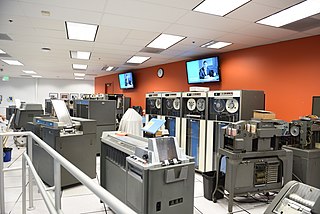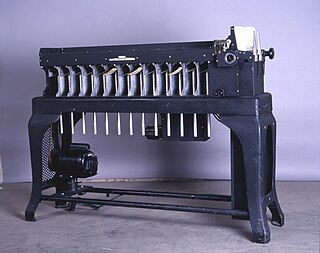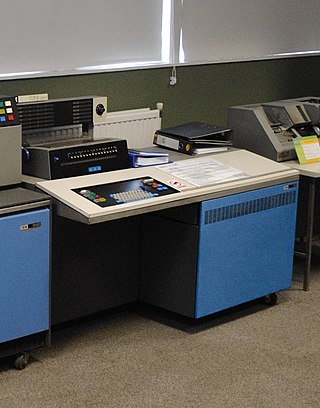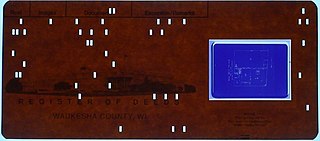Related Research Articles

In computing, a printer is a peripheral machine which makes a durable representation of graphics or text, usually on paper. While most output is human-readable, bar code printers are an example of an expanded use for printers. Different types of printers include 3D printers, inkjet printers, laser printers, and thermal printers.
In computing, a computer file is a resource for recording data on a computer storage device, primarily identified by its filename. Just as words can be written on paper, so too can data be written to a computer file. Files can be shared with and transferred between computers and mobile devices via removable media, networks, or the Internet.

A punched card is a piece of card stock that stores digital data using punched holes. Punched cards were once common in data processing and the control of automated machines.

A text editor is a type of computer program that edits plain text. An example of such program is "notepad" software. Text editors are provided with operating systems and software development packages, and can be used to change files such as configuration files, documentation files and programming language source code.

Punched tape or perforated paper tape is a form of data storage device that consists of a long strip of paper through which small holes are punched. It was developed from and was subsequently used alongside punched cards, the difference being that the tape is continuous.

The IBM 1620 was announced by IBM on October 21, 1959, and marketed as an inexpensive scientific computer. After a total production of about two thousand machines, it was withdrawn on November 19, 1970. Modified versions of the 1620 were used as the CPU of the IBM 1710 and IBM 1720 Industrial Process Control Systems.

The IBM 1401 is a variable-wordlength decimal computer that was announced by IBM on October 5, 1959. The first member of the highly successful IBM 1400 series, it was aimed at replacing unit record equipment for processing data stored on punched cards and at providing peripheral services for larger computers. The 1401 is considered by IBM to be the Ford Model-T of the computer industry due to its mass appeal. Over 12,000 units were produced and many were leased or resold after they were replaced with newer technology. The 1401 was withdrawn on February 8, 1971.

ISO/IEC 7810Identification cards — Physical characteristics is an international standard that defines the physical characteristics for identification cards.

A punched card sorter is a machine for sorting decks of punched cards.

The IBM 1130 Computing System, introduced in 1965, was IBM's least expensive computer at that time. A binary 16-bit machine, it was marketed to price-sensitive, computing-intensive technical markets, like education and engineering, succeeding the decimal IBM 1620 in that market segment. Typical installations included a 1 megabyte disk drive that stored the operating system, compilers and object programs, with program source generated and maintained on punched cards. Fortran was the most common programming language used, but several others, including APL, were available.

A flat-file database is a database stored in a file called a flat file. Records follow a uniform format, and there are no structures for indexing or recognizing relationships between records. The file is simple. A flat file can be a plain text file, or a binary file. Relationships can be inferred from the data in the database, but the database format itself does not make those relationships explicit.

Starting at the end of the nineteenth century, well before the advent of electronic computers, data processing was performed using electromechanical machines collectively referred to as unit record equipment, electric accounting machines (EAM) or tabulating machines. Unit record machines came to be as ubiquitous in industry and government in the first two-thirds of the twentieth century as computers became in the last third. They allowed large volume, sophisticated data-processing tasks to be accomplished before electronic computers were invented and while they were still in their infancy. This data processing was accomplished by processing punched cards through various unit record machines in a carefully choreographed progression. This progression, or flow, from machine to machine was often planned and documented with detailed flowcharts that used standardized symbols for documents and the various machine functions. All but the earliest machines had high-speed mechanical feeders to process cards at rates from around 100 to 2,000 per minute, sensing punched holes with mechanical, electrical, or, later, optical sensors. The operation of many machines was directed by the use of a removable plugboard, control panel, or connection box. Initially all machines were manual or electromechanical. The first use of an electronic component was in 1937 when a photocell was used in a Social Security bill-feed machine. Electronic components were used on other machines beginning in the late 1940s.

A keypunch is a device for precisely punching holes into stiff paper cards at specific locations as determined by keys struck by a human operator. Other devices included here for that same function include the gang punch, the pantograph punch, and the stamp. The term was also used for similar machines used by humans to transcribe data onto punched tape media.
A two-line element set or three-line element set (3LE) is a data format encoding a list of orbital elements of an Earth-orbiting object for a given point in time, the epoch. Using a suitable prediction formula, the state at any point in the past or future can be estimated to some accuracy. The TLE data representation is specific to the simplified perturbations models, so any algorithm using a TLE as a data source must implement one of the SGP models to correctly compute the state at a time of interest. TLEs can describe the trajectories only of Earth-orbiting objects. TLEs are widely used as input for projecting the future orbital tracks of space debris for purposes of characterizing "future debris events to support risk analysis, close approach analysis, collision avoidance maneuvering" and forensic analysis.

A microform is a scaled-down reproduction of a document, typically either photographic film or paper, made for the purposes of transmission, storage, reading, and printing. Microform images are commonly reduced to about 4% or 1⁄25 of the original document size. For special purposes, greater optical reductions may be used.
A card reader is a data input device that reads data from a card-shaped storage medium and provides the data to a computer. Card readers can acquire data from a card via a number of methods, including: optical scanning of printed text or barcodes or holes on punched cards, electrical signals from connections made or interrupted by a card's punched holes or embedded circuitry, or electronic devices that can read plastic cards embedded with either a magnetic strip, computer chip, RFID chip, or another storage medium.

From the invention of computer programming languages up to the mid-1970s, most computer programmers created, edited and stored their programs line by line on punch cards.

An aperture card is a type of punched card with a cut-out window into which a chip of microfilm is mounted. Such a card is used for archiving or for making multiple inexpensive copies of a document for ease of distribution. The card is typically punched with machine-readable metadata associated with the microfilm image, and printed across the top of the card for visual identification; it may also be punched by hand in the form of an edge-notched card. The microfilm chip is most commonly 35mm in height, and contains an optically reduced image, usually of some type of reference document, such as an engineering drawing, that is the focus of the archiving process. Machinery exists to automatically store, retrieve, sort, duplicate, create, and digitize cards with a high level of automation.

A computer punched card reader or just computer card reader is a computer input device used to read computer programs in either source or executable form and data from punched cards. A computer card punch is a computer output device that punches holes in cards. Sometimes computer punch card readers were combined with computer card punches and, later, other devices to form multifunction machines.
The term digital card can refer to a physical item, such as a memory card on a camera, or, increasingly since 2017, to the digital content hosted as a virtual card or cloud card, as a digital virtual representation of a physical card. They share a common purpose: identity management, credit card, debit card or driver's license. A non-physical digital card, unlike a magnetic stripe card, can emulate (imitate) any kind of card.
References
- ↑ "RFC 678: Standard File Formats". ietf.org. Retrieved June 1, 2019.
- ↑ "Definition of: punch card". PC Magazine. Retrieved Oct 2, 2019.